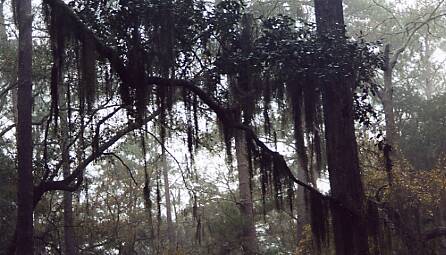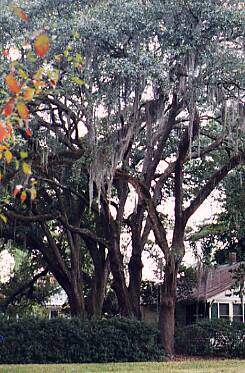|
Legends, and Facts, About Spanish Moss

The Legend of Spanish Moss
A villain there was named Gorez Goz
Who journeyed here from Spain.
The natives feared him much because
His heart was set on a gain.
Gorez espied an Indian maid
Who filled his fondest hope.
He bought her for a yard of braid
And a little bar of soap.
The Indian maid was sore afraid
And fled this bearded brute.
She sped o'er hill and field and glade
With Gorez in pursuit.
At last the maiden climbed a tree;
The Spaniard did the same.
The lass was bent on being free;
Gorez desired his claim!
She balanced on a slender limb
Then dove into the brook.
She much preferred a morning swim
To this bearded Spanish crook.
The troubles of Gorez begin,
His naughty plans are queered.
He snags the whiskers of his chin
The branches hold his beard.
The Indian maiden thus is free,
Gorez's life is a loss,
But his beard lives on for you to see
As dangling Spanish Moss!
T. S. Y.

or The story says that Gorez Goz,
a Spanish bearded villain,
journeyed to our shores and spied
a beautiful Indian maid.
He bought for her a yard of braid
and a little bar of soap. She was so afraid of this bearded
beast that she fled over hill and
glade with him in pursuit. Tiring at
last, she climbed to the top of
a tree and as he followed, she
escaped, while the villain's whiskers
became entangled in the branches. Gorez Goz's life was at a loss, but
his beard lives on as dangling
Spanish Moss. Exotica, an encyclopedia of tropical and near-tropical plants, defines Spanish moss as:
 "Tillandsia usneoides (S. E. United States to Argentina and Chile) ... growing from trees as
silvery-gray threadlike masses to 25 ft. long, densely covered by the gray scales which are a means of receiving and holding atmospheric moisture, and which help to enable the plant to dispense with roots; small axial flowers with petals 3/8 in. (1 cm) long, in changing colors yellowish-green to blue." "Tillandsia usneoides (S. E. United States to Argentina and Chile) ... growing from trees as
silvery-gray threadlike masses to 25 ft. long, densely covered by the gray scales which are a means of receiving and holding atmospheric moisture, and which help to enable the plant to dispense with roots; small axial flowers with petals 3/8 in. (1 cm) long, in changing colors yellowish-green to blue." Spanish moss is not a true moss - in fact it's a relative of the pineapple. They both belong to the division Magnoliophyta , class Liliopsida, order Bromeliales, and to the plant family Bromeliacae. While other plants of this family may grow on fences, telephone wires, etc., Spanish Moss only grows on trees. If you find it elsewhere, it probably was blown there by the wind and will soon die. Spanish moss is a Epiphyte. This means it draws nutrients and moisture from the air. It is NOT parasitic to the tree. It only uses the tree for support. The only damage it may cause is by breaking a weak limb.
When the moss absorbs moisture its weight can increase tenfold. If there is enough bloated moss on a thin, weak, or dead limb it can cause the limb to break off. "Tree Hair" was the name Native Americans used to describe Spanish Moss. French explores dubbed it "Spanish Beard" as an insult to their neighbors and rivals. The Spanish, in turn, called it "French Hair." Spanish Moss survived as the common name.
Birds, snakes, and bugs all use Spanish Moss as shelter. Humans used to have "Moss Pulling Parties." They would pull the moss from the trees, boil it to kill any bugs, then use the moss to stuff their mattresses. Moss was also used as kindling and, when mixed with mud, as caulk for homes. Medicinal uses for Spanish Moss are being explored. Because Spanish Moss can be sensitive to pollution, if you live in the south, have trees in your yard,
and do NOT have Spanish moss, you may want to wonder... why not? Sources: Beaufort County Public Library
|